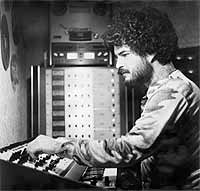Double Eclipse Liner Notes
Side A
1. NIGHT TRIPPER (Petersen) 4:08
2. VOYAGER (Petersen) 4:20
3. FUGUE IN G MAJOR ("The Jig") (J. S. Bach) 3:08
4. DOUBLE ECLIPSE (Petersen) 2:39
5. MASQUE (McBeth) 7:23
Side B
6. DANCE ON THE SUN (Petersen) 8:52
7. CANON IN D (Pachelbel) 7:05
8. DANCE FOR BRASS QUINTET (Renwick) 1:20
9. COSMIC CANNONBALL (Petersen) 5:45
10. LIGHTSPELL (Petersen) 6:08
All selections BMI.
Copyright 1981, Loch Ness Productions, except MASQUE (Copyright 1968, Southern Music Company. Used by permission.) and DANCE FOR BRASS QUINTET (Copyright 1973, Tromba Publications. Used by permission.)
Music performed on customized Oberheim TVS-1 polyphonic synthesizer, EMS Synthi AKS synthesizer, Rhodes electric piano, and Mellotron by Mark C. Petersen.
Banjo solo on COSMIC CANNONBALL by Eric Holle.
Custom signal processing devices and technical assistance generously provided by Richard W. Bates of Bates Electronic Music Systems.
Eclipse photo by Rick Wasson.
Album photography by James H. Sharp.
Contributing engineer: John Lundell.
Thanks to C. Collins Petersen, Jim Sharp, Wilke Renwick, W. Francis McBeth, Max Hannum, and Susan Winter.
Mixed at Maximum Sound Studios, Denver, Colorado.
Disc mastered at Creative Sound, Malibu, California.
 Because of the incredibly diverse array of sounds and virtually endless possibilities in which the synthesizer allows them to be arranged, albums of music performed on synthesizer are not always easy to classify or describe. Some are in the realm of the avant-garde and non-human-generated computer music, with its bleeps and blorps and growls and whines (at one time, some closed-minded "scholars" insisted that this was the only milieu in which the instrument should be heard).
Because of the incredibly diverse array of sounds and virtually endless possibilities in which the synthesizer allows them to be arranged, albums of music performed on synthesizer are not always easy to classify or describe. Some are in the realm of the avant-garde and non-human-generated computer music, with its bleeps and blorps and growls and whines (at one time, some closed-minded "scholars" insisted that this was the only milieu in which the instrument should be heard).
There are "exploitation" albums, with simplistic, cliché sounds quacking out a selection of movie themes, Christmas carols, or flying-saucer fantasies. There are the classical music realizations — the first popularly successful approach, and still a viable showcase for synthesis — not to be viewed as a "jazzing up for modern tastes". Many are exquisitely crafted new performances, perhaps historically accurate and reverential to the originals, or flavored by decades of musical change and progress.
Finally, there are those few albums in which the music is strikingly original and refreshing; unique, novel, but still retaining enough familiar elements to fascinate rather than alienate the listener. These are modern, yet classical in approach to the performance, and perhaps most importantly, they feature music which is pleasant to listen to, for whatever reasons.
It is in these last two categories that the music on the second Geodesium album belongs. Double Eclipse showcases a wide variety of styles of music — a selection for every taste. In each case, it is the music which is in the main focus, not the instrument. It is not what the synthesizer can do that is each performance's raison d'être, but how the musician utilizes the instrument in making musical statements pleasing and enjoyable to the listener — which is what music is all about.
NIGHT TRIPPER
Night Tripper marks the first time that Geodesium has incorporated synthesized drum tracks in a composition — a technique further refined in the performances of Dance on the Sun and Cosmic Cannonball. This fast-paced and intense work was performed in real time (unlike the Fugue in G Major, which was recorded at half speed for accuracy) and utilizes the EMS Synthi's capacitance-strip "keyboard" for the "sliding" melody and solo lines.
VOYAGER
It may be impossible for those of us bound to our home planet to fully comprehend the endless depths of space. In continuing guessing games, we try to describe it — the universe — the cosmos. As scientists, we measure and map the heavens, assigning empirical names to phenomena we see but cannot understand. As a species, we search the stars for answers about our origins. As human beings, we perceive the cosmos through our emotions: curiosity, fear of the unknown, love of distant places, yearning for discovery, and the excitement of learning strange new things. Voyager is a mood piece, composed to evoke these emotions in the listener — to convey a sense of the beauty and limitless possibilities that exist in the infinite universe.
FUGUE IN G MAJOR ("The Jig")
There is no doubt about it — Johann Sebastian Bach is a popular composer among synthesists. From Wendy Carlos' pioneering works to this performance, Bach's music has become a staple in the synthesizer repertoire. His compositions are precise, crisp explorations into tonality and form that remain unparalleled in achievement, always offering musical delights to listener and performer alike. Geodesium offers Fugue in G Major ("The Jig") as a faithful transcription of the Bach original, with synthesizer voicings. For those Bach purists, this performance utilizes an inverted turn for ornamentation at the end of the first theme statement, instead of the indicated mordant. This adds a more joyous touch to the obvious exuberance of the work. The "jig dancer" doesn't simply curtsy at this point, but performs a boisterous pirouette! This change is well within the rules for 18th century ornamentation.
DOUBLE ECLIPSE
Double Eclipse is a musical description of the haunting, mysterious vision of a total solar eclipse. Its moodiness suits the drama of Rick Wasson's cover photograph of the 1979 eclipse as seen from Goldendale, Washington. The visual and aural themes complement each other to offer one impression of the experience of such an extraordinary spectacle.
MASQUE
Music written for the concert band or wind ensemble has often been deemed "second-class" when compared to works for string orchestra. However, when played on synthesizer, the original performing medium becomes irrelevant, and the music itself becomes the prime consideration. Concert band music can be as dramatic, exciting, and every bit as significant as orchestral music. Indeed, composers better known for string orchestra works — Respighi, Elgar, Barber, Dvorak and many others — have also composed for the wind ensemble. Of course, band literature has very competent composers of its own. One eminent name in the field is W. Francis McBeth, who has written MASQUE and other acclaimed works. This 36-track realization of McBeth's score (done on one eight-track recorder) presents synthesizer voicings in an imitative, yet still unique arrangement. The only non- score sound is the wind heard in the slow chorale section. It is an interesting note that, upon hearing this performance, Dr. McBeth remarked that he preferred the wind sound, and had in fact considered scoring a wind machine in that section when he originally composed the work.
DANCE ON THE SUN
Dance on the Sun is a lively, bouncy rock tune, utilizing some space-music stylings in otherwise terrestrial melodies and chord changes. Adding spontaneity and musicality is the synthesized "drummer", playing fills and figures not possible on automatic rhythm boxes. With a developing solo section done in the improvisatory rock style, and two lead soloists leaping about the "stage", Dance on the Sun is fun from start to finish.
CANON IN D
It is entirely possible to capture the spirit of a classical music composition with an electronic realization, and make the new performance as moving as any other. In this transcription of Johann Pachelbel's Canon in D, the rich tranquility of the original quintet has been captured, and orchestrated to offer listeners a fresh experience with this 17th century classic.
DANCE FOR BRASS QUINTET
Dance for Brass Quintet is a composition by Wilke Renwick, who was principal French Hornist for the Denver Symphony Orchestra for some years. His piece's catchy rhythms are patterned after Greek folk dances, and utilize a mixed bag of meters. The melody line remains light and cheerful, to contrast the driving bass figures. In this performance, the synthesizer brings out the rhythms and meters with a brilliant clarity perhaps unattainable by acoustic wind instruments.
COSMIC CANNONBALL
Cosmic Cannonball presents what is certainly the first performance ever to blend electronic, rock, jazz, disco, and bluegrass music in one piece. The "drum" synthesizer has a pitch range far beyond conventional instruments. Highlighting the piece is an intense solo by noted banjoist Eric Holle that captures the characteristic excitement of bluegrass pickin' at its best. This spicy, lively, driving, unusual piece of music is guaranteed to set your foot a-tappin'!
10. LIGHTSPELL
A sequencer-based, moving space music flight, in the style of Voyager.
— Carolyn Collins Petersen


